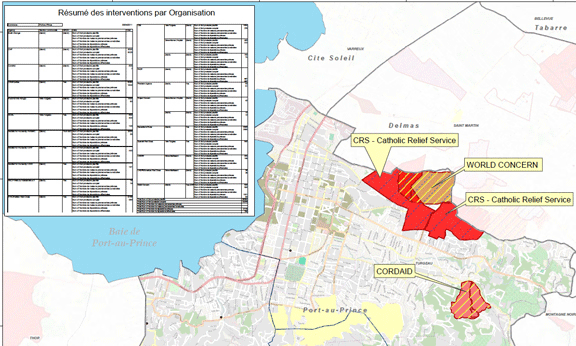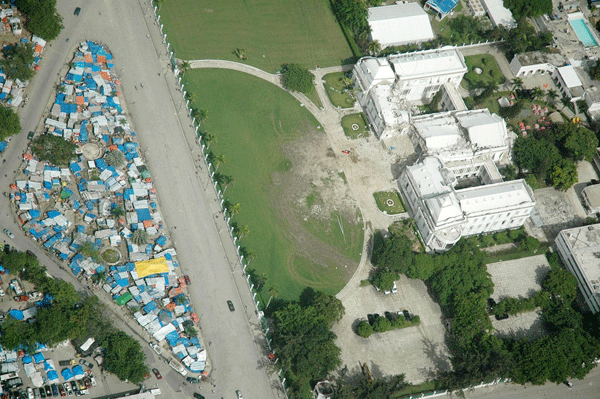While the heroes are watching
Champ de Mars homeless left hopeless
Part 2 of 2
Port-au-Prince, June 9 – After the January 12, 2010, catastrophe, many more international agencies working in the housing domain came to Haiti.
According to information obtained by Haiti Grassroots Watch (HGW) and the Laboratoire du Journalisme from the meeting minutes and other documents of the "Shelter Cluster" – which brings together all the agencies and organizations working in the sector – earthquake-affected areas are divided up into cities and zones. The city of Port-au-Prince has 18 agencies and organizations working on the shelter issue, according to Cluster documents.

Shelter Cluster chart showing where organizations are building T-Shelters or doing repairs. There are no organizations working in downtown Port-au-Prince.
All told, the agencies and organizations intend to build 26,594 temporary shelters or “T-Shelters,” to repair 2,174 houses, and to construct 155 permanent homes in Port-au-Prince. But that is far from sufficient. According to a March report from the International Organization for Migration (IOM), 47,059 Port-au-Prince camp families are in need of housing.
Despite the planning and supposed division of labor by the humanitarian organizations and the government, and as paradoxical as it might seem, nobody from the shelter sector is operating in any of the Champ de Mars camps.
One reason might be because the location of agencies is not the result of a distribution of tasks or a coordination overseen by one all-powerful authority. There is no "Minister of Housing," and in fact for months national Cluster meetings had no government presence. As for the Cluster coordinator, he or she can only suggest where an agency should operate.
The Interim Haiti Recovery Commission (IHRC) – in charge of Haiti’s post-January 12, 2010, recovery – could direct inverventions in the shelter and housing domain. According to the law which created the commission, it is supposed to “conduct strategic planning and coordination and implement resources from bilateral and multilateral donors, non-governmental organizations, and the business sector…” but at Champ de Mars, at least, the IHRC has not delivered the goods.
According to Emmanuel Gay of the IOM, which is responsible for coordinating the humanitarian actors in the camps, his organization only gets involved in shelter issues after a serious storm or another catastrophic situation.
“As soon as there is a need, we are called and we respond, mostly in crisis situations, like during rainy season we aid the most vulnerable people by helping them improve their shelters,” he told HGW.
Gay noted that IOM is working on “a plan of ‘return’ for all refugees, but he also said “we are not there yet.” Difficult to understand the delay in the execution of the alleged plan of return for homeless people who have already lived almost 17 months in demeaing circumstances.
The IOM representative also alluded to one of the possible reasons for the delay:
“I think there is a government social housing project in the works for Fort National. Many of the homeless from [Champ de Mars] are signed up, but I don’t have any more details than that.”
Perhaps the project is the reason no shelter agencies are working at Champ de Mars?
The mysterious Fort National project
Gay was alluding to a social housing project that the government tried to launch on January 12, 2011. Perhaps But Minister of Social Affairs Gérald Germain was met by furious residents hurling rocks and glass bottles in the neighborhood on a hill a few kilometers from the Palace.
“We want explanation! We want to know how the government intends to help the people who, long before January 12, lived in infrahuman conditions. It is unacceptable in the 21st century!” one of them told the online news agency AlterPresse. [See the story on this website.]
According to the outgoing Minister of Finances and Economy, Ronald Baudin, the project is moving forward but is not yet at the execution state.
“Part of the money is ready, the plans are done… the models have already been built. We just need to clear the sites so we can begin the building,” he told HGW.

Flier handed out in Fort National neighborhood on January 12, 2011. The writing says: "Haitians let's take the destiny of our country in hand."
But a CIRH authority has doubts about the project. Priscilla Phelps, CIRH’s Principal Counselor for Housing and Neighborhoods, told AlterPresse on January 12, 2011: “A lot needs to be clarified… the project needs to be vetted. It is pretty expensive.”
Questioned more recently, Jean-Christophe Adrian, Coordinator for Programs for UN-HABITAT, which heads up the Shelter Cluster at the moment, said the same thing. According to him, the project is at an impasse.
“I am not aware of any progress,” he told HGW.
Adrian remembers the near-daily meetings at the National Palace aimed at planning the evacuation of Champ de Mars and the refugees’ return to their home neighborhoods.
“It was President Préval’s initiative,” he recognized, and all the agencies were enthusiastic about the success of the pilot project, since “the only solution is to allow people to return to their neighborhoods.”
But the meetings and discussions suddenly ended.
“Well, I don’t have all the information but in fact… according to what I understand, the decision was taken to do a big operation at Fort National,” Adrian remembered.
Similar to Phelps, Adrian does not think large social housing developments are the best solution. One of the reasons is that, historically, usually the middle class is the one that benefits.
Haiti Grassroots Watch turned to Port-au-Prince Mayor Jean Yves Jason to ask him what had been done or will be done for the Champ de Mars refugees who are, after all, residents of his city.
According to Jason, City Hall was not involved in the Fort National project.
“It was a move to help the president political platform Inite in order to buy the Bel Air voters,” he claimed in an interview via email.
In addition, Jason said he tried to liberate a few of the public squares on May 12, two days before the inauguration of the new president, but without success. City Hall has also proposed its own social housing project at Morne à Cabrit, a dry mountainside north of the capital. The pilot project would benefit 6,000 families and would cost US$76,065,000 (US$12,677.50 per family), he said.
The new president, Michel Martelly, recently circulated a document called “Closing of Six Priority Camps through the Launch of Definitive Reconstruction.” The Champ de Mars camps were not one of the “priorities.”

Credit: Timo Luege, UN Inter-Agency Standing Committee.
Nobody knows the truth about how long Haiti’s citizens will have to live in this hardly describable situation. But one truth does not escape any observer: if a hero is someone “distinguished by his action” or “who plays a principal role in history,” as the dictionaries tell us, many actors – the "non-governmental organizations," the United Nations agencies, the mayors, the ministers and the IHRC among them – are acting in almost the opposite manner in the eyes of the Champ de Mars camp-dwellers.
Maybe the homeless are the real heros. Every day they struggle for their survival against the rain, cholera, the lack of toilets, homes, schools, jobs and maybe even hope itself.
Return to Part 1
Journalist attacked and robbed while reporting this story
Students from the Journalism Laboratory at the State University of Haiti's Faculty of Human Sciences collaborated on this series.
Haiti Grassroots Watch is a partnership of AlterPresse, the Society for the Animation of Social Communication (SAKS), the Network of Women Community Radio Broadcasters (REFRAKA) and the community radios of the Association of Haitian Community Media (AMEKA).

